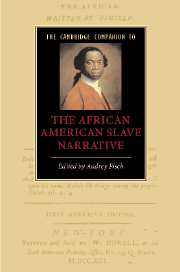Book contents
- Frontmatter
- Introduction
- Part I: The Slave Narrative and Transnational Abolitionism
- Part II: The Slave Narrative and Anglo-American Literary Traditions
- Part III: The Slave Narrative and the African American Literary Tradition
- Part IV: The Slave Narrative and the Politics of Knowledge
- 11 Harriet Jacobs: a case history of authentication
- 12 Frederick Douglass’s self-fashioning and the making of a Representative American man
- 13 Beyond Douglass and Jacobs
- 14 Black womanhood in North American women’s slave narratives
- Further Reading
- Index
11 - Harriet Jacobs: a case history of authentication
from Part IV: - The Slave Narrative and the Politics of Knowledge
Published online by Cambridge University Press: 28 July 2007
- Frontmatter
- Introduction
- Part I: The Slave Narrative and Transnational Abolitionism
- Part II: The Slave Narrative and Anglo-American Literary Traditions
- Part III: The Slave Narrative and the African American Literary Tradition
- Part IV: The Slave Narrative and the Politics of Knowledge
- 11 Harriet Jacobs: a case history of authentication
- 12 Frederick Douglass’s self-fashioning and the making of a Representative American man
- 13 Beyond Douglass and Jacobs
- 14 Black womanhood in North American women’s slave narratives
- Further Reading
- Index
Summary
Introduction: the question of authenticity
In 1987 Harvard University Press published a newly authenticated slave narrative, titled Incidents in the Life of a Slave Girl. Jean Fagan Yellin was the editor of this admirable new edition, because unlike other historians and scholars - such as the historian John Blassingame and scholar Robert Stepto - she believed the author, “Linda Brent” (Harriet Jacobs), and the original editor, Lydia Maria Child, when they said that the narrative was true. Searching through various archives, Yellin was able to find solid documentary evidence, in the form of letters, newspapers, and official state papers, as to the truth: that the incidents recounted in Incidents had actually occurred.
By proving that Harriet Jacobs had indeed composed the narrative, and that the events in it were more or less true, Yellin had single-handedly changed the book's status and the shape of what could be understood more broadly as “authentic” slave narrative, which I will discuss later in this essay. Indeed, although Incidents had been known to scholars and historians for years (it had, indeed, never really been lost), few regarded it as genuine; its value as a slave narrative was questioned or doubted, and for a host of reasons. Most critics who worked with slave narratives had labeled Incidents fiction. Indeed, Yellin herself had originally accepted “received opinion” and had “dismissed it as a false slave narrative” (Incidents, p. vii). Why?
- Type
- Chapter
- Information
- The Cambridge Companion to the African American Slave Narrative , pp. 189 - 200Publisher: Cambridge University PressPrint publication year: 2007
- 1
- Cited by

